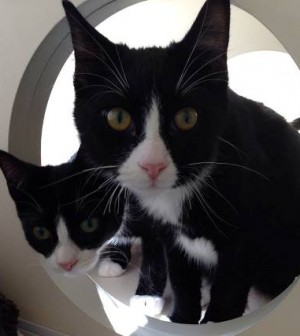- Do you subscribe to Dharma Dog Training’s Newsletter? You should.
- A Unique Campaign from The Humane Society of the United States
- Rabid bats in Omaha- Stay safe, prepared with these tips
- Springtime Activities in Omaha
- Mill Dog Monthly from Bailing Out Benji
- World Spay Day, Legislative Alert in Nebraska
- Attend the Nebraska Rescue Council’s monthly meeting this Saturday
- Five Hard-to-Ignore Reasons to Adopt!
- Paws in Pink to Benefit Breast Cancer Foundation
- VCA, Inc. Acquires MidWest Vet Specialists from Kansas State University
Understanding Outdoor Cats, Feral and Stray

Estimates say that somewhere around 70 million stray or feral cats live in the United States. And though there isn’t much of a “problem” here in Omaha, there are places where cats congregate or “colonize.” Knowing this, cat advocates like Feline Friendz utilize the Trap, Neuter, Return method of caring for kitties. This way, the cats, who aren’t likely social, who likely haven’t had any care, can still live without reproducing or spreading disease. It’s one of the best ways people know how to deal with the massive number of stray and feral cats we have
Laurie Cook was nice enough to answer a couple of questions for us so we could educate our readers on TNR, what Feline Friendz does on a daily basis, and how the population problem is being dealt with. Below are the questions and answers; if you have additional questions, please use our Contact page or comment on this post! We’ll get you the information you need.
Q: Can you tell readers about the typical Feline Friendz TNR process, start to finish?
A: We normally get a call on our voicemail or receive an e-mail from someone who is caring for feral cats. Often times, they started off feeding one or two cats, but the cat population multiplied exponentially and by the time someone reaches out to us, they are overwhelmed. When we can, we try to get a couple of traps to the location and the caretakers take the back door of the trap off to get the cats used to going in and out of the traps. We have surgeries twice a week at two different locations. We show the caretakers how to trap the cats and they bring them in for surgery. The cats are normally trapped the night before surgery, have their surgery the next morning, then are released to their home territory the day after surgery.
Q: Cat colonies can be anywhere, but are there special ones that Feline Friendz tends to? Where?
A: There are feral colonies all over Omaha. We have a few colonies that we assist with feeding, but there are many more feral colonies than those that we feed. Feral colonies are really everywhere – North Omaha, South Omaha, Mid-town, West Omaha, Bellevue and all surrounding areas. We keep logs of the cats we have helped, and pretty much every zip code in and around Omaha is included in our logs. For the safety of the cats, we are not able to provide information about where feral cats are located. Many of our locations are licensed feral colonies through the Humane Society. Feral cat caretakers can work with us or other rescue groups, and they can also work directly with the Nebraska Humane Society to get the cats altered.
Q: Are there special regulations/policies in and around Omaha pertaining to colonies and people who care for them?
A: Yes, there are regulations/policies regarding feral cat colonies. It is actually illegal to feed feral cats without a feral cat permit. One can obtain a feral cat permit through the Nebraska Humane Society. The cost of a feral cat permit is $25 and the permit lasts for two years. The caretaker must be actively working to spay/neuter all of the cats within their colony. The cats are also given a rabies vaccine and their ears are clipped, so they are identified as an altered feral cat. If NHS picks up an eartipped feral, they can return it to its home territory if the caretaker has registered for the colony permit. We encourage people to get the permits through the Nebraska Humane Society – first so they can legally feed the cats, and also so their cats can be returned if they are picked up by NHS.
Q: What are the biggest obstacles Feline Friendz has in caring for community cats? How can people help?
A: In my opinion, one of our biggest issues is that people are often looking for cat removal, versus trap/neuter/return. We don’t have a place to house feral cats, and the most we can offer is assistance with getting the cats altered and returned to their home territory, where they know how to survive.
Q: If there is a typical cat colony, please describe it.
A: I have been assisting with TNR for over 12 years now. I can’t say there is a typical colony. There are feral colonies of two cats, colonies of 20 + cats and everything in-between. The ideal colony is one where all cats have been caught, spayed and neutered, and stabilized. One of the locations I worked on 12 years ago had 25+ cats when we started. We were able to capture all of the cats. If there were young kittens, we placed them in foster care and found homes for them. The adults were altered and returned to that location. The cats are fed daily, have shelter, and over the years, the colony size has diminished through attrition and is now down to 3 cats, who are still well cared for. TNR works and is a humane option for cats who were born in the wild and are too feral to socialize. They can live long, healthy lives if they are altered, and given food and shelter.
For more information on understanding outdoor cats, feral and stray, take a look at this link from The Humane Society of the United States.
If you’d like to learn how to help Feline Friendz, please visit its website here.
Related Posts
Latest News
-
3 Tips for Pet Owners on Training Rescue Dogs
Owning a rescue dog can take some work compared to...
- Posted 3 weeks ago
- 0
-
Choosing the Right Pet for Your Lifestyle
Are you thinking about getting a pet but unsure what...
- Posted 1 month ago
- 0
-
How to Make Your Rescue Pet as Comfortable as Possible
Did you bring home a new pet from a shelter...
- Posted 2 months ago
- 0
-
How Having A Pet Can Change Your Life
Having a pet can open your heart in ways that...
- Posted 7 months ago
- 0
-
How To Improve The Life Of Your Senior Pet
Do you have an elderly fur baby and want to...
- Posted 8 months ago
- 0
-
Springtime Activities To Enjoy With Your Furry Friends
Are you preparing for warmer weather and want some ideas...
- Posted 9 months ago
- 0
-
Pros And Cons Of Microchipping Your Pets
Have you considered whether your pets should be microchipped and...
- Posted 9 months ago
- 0






















You must be logged in to post a comment Login